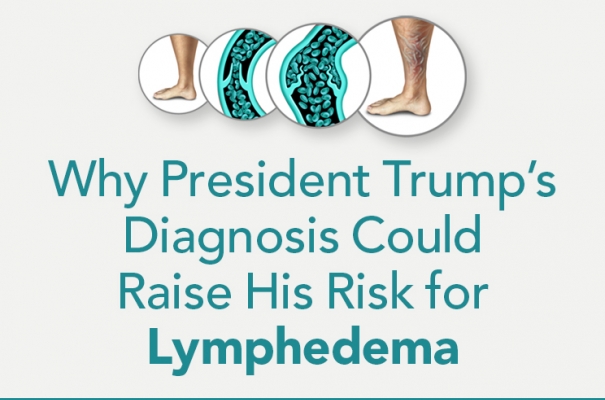On July 17, the White House confirmed that President Donald Trump has been diagnosed with chronic venous insufficiency (CVI), a condition that impairs blood flow in the legs and can lead to persistent swelling.
What the public—and even many healthcare providers—may not realize is that CVI can place a person at high risk for lymphedema, a chronic and incurable disease that affects millions and remains widely misunderstood, misdiagnosed, and neglected in healthcare.
To explain this critical connection, LE&RN consulted leading experts Dr. Stanley G. Rockson, Allan and Tina Neill Professor of Lymphatic Research and Medicine, Stanford University School of Medicine, and Professor Peter Mortimer, Emeritus Professor of Dermatological Medicine at City St George’s, University of London, who shared their insights on why this risk is significant.
What is Chronic Venous Insufficiency (CVI)?
CVI happens when the valves in the veins stop working properly, causing blood to collect in the legs. Over time, the increased pressure forces fluid out of the tiny blood vessels (capillaries) and puts too much strain on the lymphatic system, which normally helps drain this extra fluid back into the bloodstream.
5 Things to Know About CVI and Increased Risk of Lymphedema
- Extra fluid from struggling veins increases the burden on your lymphatics. Blood leaking out of capillaries adds more fluid for the lymphatic system to clear away.
- Inflammation and tissue changes make things worse. Poorly managed CVI creates an environment full of inflammation and even infection, setting the stage for lymphatic failure.
- The lymphatic system has no central pump like the heart. Lymph moves slower than blood and relies on vessel contractions and one-way valves. If too much fluid floods the system, the lymphatic vessels get overwhelmed.
- Eventually, lymphatics can be damaged, leading to secondary lymphedema. In advanced CVI, the constant overload and inflammation may cause the lymphatics to fail—this combined condition is often called “phlebolymphedema.”
- New guidelines recognize this critical overlap. In December 2019, an expert consensus led by the American Venous Forum concluded that CVI (especially in its advanced stages) is a leading risk factor for secondary lymphedema. All patients with severe CVI should also be considered at risk for lymphedema and managed accordingly.
Dr. Rockson explains how CVI strains the lymphatic system: “Think of a traffic jam at rush hour: the dramatic increase in the number of cars on the road renders the highway inefficient and, consequently, all traffic moves at a much slower rate. This metaphor accurately describes the impact of CVI on the function of the lymphatics. While they can remain structurally normal, at least for some time, the quantity of lymph that they must transport is so elevated that, at a certain point, the previously healthy lymphatics can no longer prevent edema (swelling). In this case, the ‘traffic jam’ is the accumulated tissue water that we call edema.”
As Prof. Mortimer describes, the science is straightforward: “Any fluid edema is caused by an imbalance between vascular filtration (fluid leaving the veins and entering body tissues) and lymph drainage. The most important factor in tissue fluid homeostasis is the drainage of interstitial fluid by the lymphatic system, rather than reabsorption by venous capillaries. In CVI, the pressure in varicose veins forces more fluid out into the legs. If the lymphatic system is doing its job properly, fluid is drained, and swelling is avoided. If the lymphatic system fails in its role, then lymphedema arises.”
Prof. Mortimer warns that public and medical understanding of lymphedema remains alarmingly limited: “There is huge ignorance which makes lymphedema a Cinderella of diseases. It has been neglected in medical research and not adequately taught in the training of doctors and other healthcare professionals. Lymphedema is arguably one of the most misunderstood diseases in healthcare today, yet one of the commonest.”
Where to Turn for Help
Visit the LE&RN Resource Center
LRC@lymphaticnetwork.org
1-855-378-8163
The LE&RN Resource Center is a free service offering expert guidance, educational tools, and referrals to LE&RN Centers of Excellence—70 institutions delivering gold-standard diagnosis, treatment, and care for lymphatic diseases.
